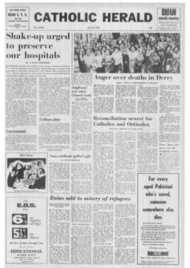Page 4, 16th July 1971
Page 4

Report an error
Noticed an error on this page?If you've noticed an error in this article please click here to report it.
Tags
Share
Related articles
'workshop' Quest For Faith
Mutiny, Hope And Bewilderment In Dutch Church
Celebrating The Presence Of The Lord
Even Holland Has Moderates And Latin Mass
Do Changes Make Church-going More Interesting?
The Dutch quest for God
by BRIAN G.
COOPER
LIKE many Dutch parishes, but more famous than most. St. Dominic's, Amsterdam, has become a worship workshop. Sunday by Sunday it is engaged in that liturgical renewal which is central to the so-called "revolution" in the Dutch Catholic Church. la the Netherlands today, renewal of worship is not seen as something static. achieved by mere implementation of Vatican 11's decrees. but as a continuous ongoing process undertaken , in the Council's spirit of radical openness.
Lay participation is a vital part of it in many churches. priests have given up sole responsibility fur preparation and conduct of services, now sharing this task with lay groupa drawn from different age and interest levels in the congregation. At St. Dominic's, "building the parish by way of the liturgy" is the theme. Every Thursday, the Clergy team of Jesuits, Dominicans and secular priests join. young singers and musicians, and adult laity from the congregation, to plan weekend Euehariats for the weeks ahead. Another group works out the sermons. so that what the priest preaches is rooted in real life demands from among the parishioners, who will not let the clergy get away with theological abstractions.
St. Dominic's worship-style is disseminated throughout the Netherlands via its recording studio and disc-production company. and .its theology of -the participatory parish" is widely followed. too. Father Niewenhuis put it like this: "Here people don't come for a spectacle. Liturgy should not be some kind of consumption, but rather a kind of production, the tnaking of a community. We must make the liturgy together. as we take the broken bread together, so that we can be broken together in sharing each other's burdens, as Christ himself was broken for others."
For clergy-leader Father W.
Tepe, 0.P., "team-created liturgy is at the heart of our search for a new way of experiencing what it means to be the chur.ch, from below, and
without the massive, burdensome and impersonal structures choking and stifling us."
The quest for spiritual liberation and the discovery of Gospel spontaneity are twin dynamics within the Dutch renewal. Groups of children sing, dance and mime in this particular Sunday morning Eucharist. Their gay. chaotic art may decorate a church's ancient walls — or world jxwerty posters may be sellotaped among the statues and stained glass. Rabbi and priest come together to read and interpret the Old Testament. Catholic and Buddhist stand before the altar, offering common prayers for peace in Vietnam.
A 1971-style procession with placards pauses to pray at the Stations of the Cross, and declares Christ to be agonising still, among the poor and oppressed of the Third World. A young ballet dancer performs a "Resurrection dance" before the altar, while a progressive music group strums in a corner. A city-centre priest chats over parish news with worshippers while the collection is taken informally. A coffee bar, at the side of the nave, is the rendezvous as soon as worship is over. A sermon gains visual impact with slides flashed on a screen. The Dutch are exploring many avenues of liturgical change — "every Sunday is a new Eucharistic adventure" — but gimmickry is rare.
An ecumenical welcome to the Holy Table is very general. It is rarely proclaimed; it is normally assumed. No one seems to make any fuss about open Eucharist. and the very matter-of-factness is highly significant. Some priests even welcome non-Christians. and not only Protestants: "I see the Eucharist as a sign of human solidarity, as well as of God's solidarity with man, and if someone at this stage of his personal pilgrimage can only appreciate the former aspect, why should I bar him from the Eucharist if he finds it personally meaningful?" asserted a Dominican industrial mission priest.
At Utrecht university's Cunera Centre. a former convent now run as a community house and ecumenical students' club, the joint Catholic Protestant (Lutheran, Reformed and R e monstrant) "University Fellowship of the Gospel" runs weekly Eucharist and Bible services attended by nearly three hundred students from across the whole denominational spectrum.
Age-old theological
obstacles to inter-communion are not surmounted with any thorough
going new Eucharistic theology, though "the theology of human and
divine solidarity" is widely attractive. Priests and people have simply come to consider — and probably a majority think
like this — that "denominational divisions are nonsense at the I ord's Table," and that "Christ's body is for all because He died for all." Few Dutch Catholics debate inter-communion; they simply do it.
If thus willing to cut through theological debate with clearcut action, Dutch Catholics are not intellectually shallow, but rather the reverse. Well-versed
in foreign languages, the Dutch man-in-the-pew has probably read Karl Rahner, John Robinson and Harvey Cox. Parish-level discussion groups and study programmes offer regular forums of laity education: topics range from Ecumenism to the Generation Gap, and Sex to southern Africa.
Some churches specialise in lay training; the Moses and Aaron church next to Amsterdam's flea-market has a current quarterly programme of some thirty courses, including Spirituality and the "Underground," Third World problems and dialogue with Marxists. Church-run cOurses in the Netherlands often draw many non-Catholics, including many non-churchgoers, so that Christian education merges into mission.
In the land of "Provos" and "Pixies," the hippy culture is widely diffused. Amid its excesses, a deep spritual yearning is real enough, and Dutch priests report a recent turningback towards more traditional forms of spirituality on the part of many erstwhile devotees of the wilder shores of astrology and yoga. Certainly hippies crowding to hear abbots expounding on Christian mysticism indicates the Faith is not automatically dismissed among the trendy young.
Indeed, both through worship as such and many other forms of parish activity Dutch Catholicism is seriously engaging with much of the current youth quest for an authentic spirituality, and in many places clearly articulating it. I will never forget Easter Saturday midnight Eucharist at St. Anne's parish, Heerlen. Over six hundred people, mainly in the teens and twenties, packed the church. Blazing torches flamed out of a darkened interior to herald Resurrection day.
Beside the altar a progressive music group strummed a mime group into symbolic New Life movement. Youngsters drank and washed in the font Water of Life. Our myriad candles shone in our hands, and joy shone on hundreds of faces as. to the sound of a lute, we crowded forward for the Paschal Bread. Around the attar, dancers and torchbearers shared the cup — and smiled to each other. Then, after rousing choruses of We Shall Overcome, we went our way. many to a parish party where Easter breakfast was followed by disco till dawn. Celebration indeed!
The quest for joy is not confined to the young, or limited to the parishes. Among the monastic orders it is readily evident.
A few miles south of Eindhoven, the St. Benedict Abbey at Achel is a cartographer's quirk : literally straddling the Dutch-Belgian border, its house is in Belgium, its 750 acres of farmland mostly in the Netherlands. If its geographical position is eccentric, its lifestyle is certainly not. In the wake of Vatican II, its Trappist monks decided to abandon asceticism behind closed doors for joyful openness to the real world. Organised in three regularly convened discussion groups, the fifty-three brothers persuaded successive abbots of the need for change.
Total silence went — but evening quiet remains. Once, visitors were rare, and necessarily ecclesiastic. Now Achel receives over three thousand overnight visitors annually, including women, and countless day visitors, youth groups and parish parties. Monastic quarters the traditional open dormitory is currently under reconstruction into separate study-bedrooms) naturally remain private, but most summer afternoons the main quadrangle resounds to the happy shouts of children.
These 1971-style Trappists have given up the tonsure, but not succumbed to materialism; farm profits go to missionary and Third World development projects, and cloister fare remains simple, though adequate.
One brother summed it up: "Everything has changed: now we are much more human. We used to think of our world on the inside as a little paradise, and the world outside as evil, but all that was unreal. Now we are no longer cut off from the world, and we are content to know we do God's will in the real world of people."
Away from unreality in a joyful quest for God's service among contemporary humanity — that's the spirit of the current renewal movement among Dutch Catholics.
blog comments powered by Disqus









